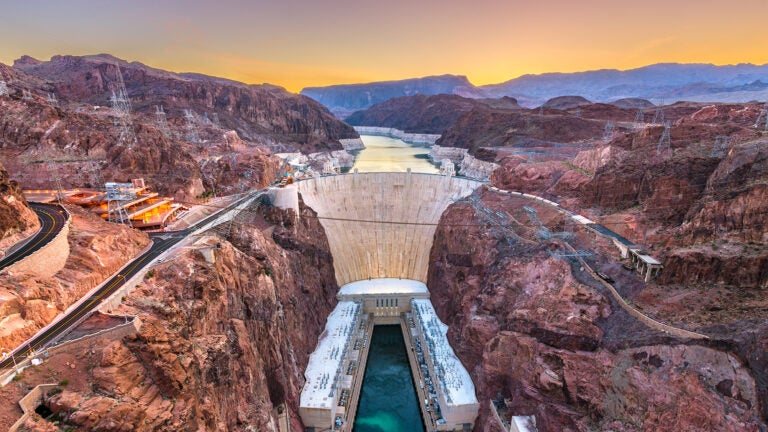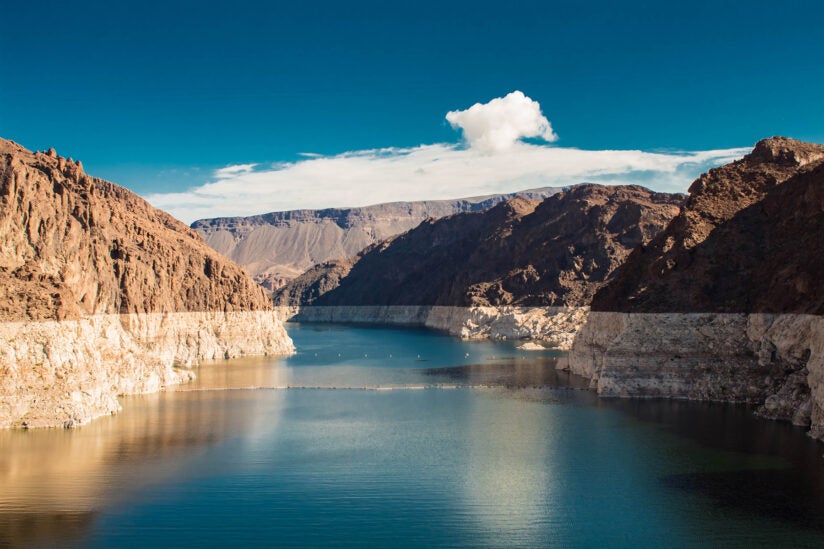
Straddling Nevada and Arizona, Hoover Dam holds back water of the Colorado River. (Photo/iStock)
Colorado River water plan could trigger unprecedented supply cuts, ripple effects on key industries
The American Southwest braces for economic impact as pressure mounts in negotiations over the river’s dwindling water supplies.
Earlier this month, the Biden administration proposed a plan to distribute cuts from the Colorado River and resolve the centurylong legal dispute between states across the American Southwest that share its water supplies.
Decades of drought and overuse have brought the river’s water levels to historic lows. States in the Lower Colorado River Basin — Arizona, California and Nevada — now must choose between one of three options proposed by the federal government.
The outcome of these talks will have far-reaching implications for agriculture and energy in the region. The Colorado River provides water for over 40 million Americans and 30 Tribal Nations, fuels hydropower resources in eight states and supports agriculture across the region.
(Story continues after video)
“Food, energy and water tend to be regulated separately, which can be problematic. You can’t change policy in one of these areas without impacting the others,” says Robin Craig, professor of law at the USC Gould School of Law.
“The Biden administration’s proposed options for dealing with the continuing Colorado River shortages capture the essential water dilemma for the West as a whole: Do we continue to honor historical patterns of water use in the West, or do we invoke principles of equity and a need to reassess what the Southwest is doing with that water?”
Option 1: Equal cuts across the Lower Basin states
Equal cuts to water allocations across the Lower Basin states would represent an unprecedented break with legal tradition that has served as the bedrock of water law in the West for over a century.

The region follows what is known as prior appropriation law, which stipulates that whoever first accessed the water and put it to beneficial use is granted senior water rights. California is the senior water rights holder on the Colorado River system and is first in line to receive its annual allotment, much to the chagrin of the other states.
“These water rights endure forever, and in the southwestern U.S., they tend to be locked up in agriculture,” says Craig. “In fact, about 80% of the water rights in the Southwest are for agriculture, and that plays into how flexible you can be in the Colorado River water distribution.
“Cutbacks across the board might work for the Colorado River itself, but within the states we will still have prior appropriation to deal with. A large pot of money to spend on transitioning the entire system seems not to be on the table.”
California officials have spoken out against this plan, arguing that it sidesteps existing water laws that respect the state’s status as senior water rights holder.
Under this plan, California farmers — particularly those in the Imperial Valley — and consumers would be hit hardest.
The Imperial Valley is the largest producer of alfalfa, or hay forage, for California dairy cows and an important source of nutrients during the winter months, explains Shon Hiatt, an associate professor of business administration at the USC Marshall School of Business. A drop in the state’s water allocation would reduce the amount of alfalfa produced since it is the least profitable crop.
Hiatt, an expert in global energy and agribusiness, says that an across-the-board cut to water supplies would mean higher prices for dairy products.
“California dairies have been struggling due to increased regulatory costs and the destruction of 60% of grazing pasture this winter due to flooding. The situation will be made worse if less alfalfa is grown and would result in higher dairy product prices in the state.”
Option 2: Cuts based on water rights seniority
Under this plan, California would retain its senior water rights to Colorado River water, with the strictest cuts imposed on Arizona and Nevada.
“In this scenario, California wins in the Lower Basin of the Colorado River — but the entire Lower Basin needs to get creative about how to free up water from agriculture without putting farmers out of business or losing food security. In other words, become more efficient about agriculture,” says Craig.
Option 3: Do nothing
The U.S. Department of the Interior lists this “No Action Alternative” as one of three options in its recent proposal.
Experts warn that doing nothing would prove disastrous for the Colorado River and the regional economy.
Regardless of how the states and federal government decide to move forward, doing nothing would mean keeping the Colorado River on the fast track to dead pool, or levels where water would no longer flow downstream and through the major dams, which generate enough hydroelectricity to power the homes of 1.3 million Americans in the region.



